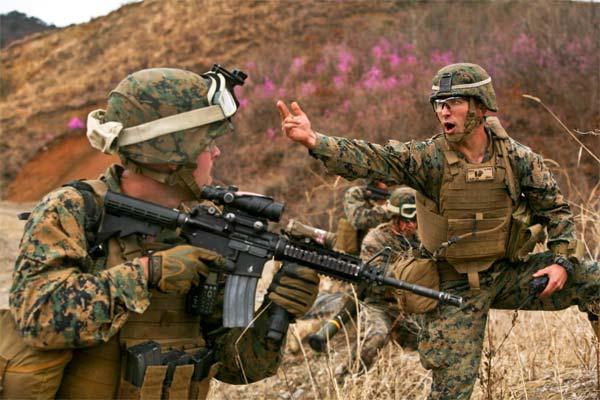Marines from the Corps' East Coast and West Coast expeditionary forces will spend several months this summer in a competition of sorts to help determine how the service will fight and train ten years from now.
This week, top brass from around the Corps are meeting in an executive off-site meeting near Washington, D.C., to discuss a plan that will use war games to shape the future force. It's part of an initiative called Force 2025, said Lt. Gen. Robert Walsh, the deputy commandant of Marine Corps Combat Development Command, who described the plan to Military.com during a recent lecture at the Center for Strategic and International Studies.
In July, Marine Corps Commandant Gen. Robert Neller plans to choose one of two separately developed plans to shape the future force, Walsh said. On course of action favors an "evolutionary" approach, making changes in a more gradual fashion and building on existing methods and practices. The other, he said, is a "revolutionary" approach that emphasizes more "out of the box" ideas and disruptive thinking.
Neller has spoken often about the Marine Corps' need to develop its capabilities, particularly in the information warfare and cyber realm. In an order published in January, he set a 2017 deadline to expand information operations, cyber, and electronic warfare.
"We will engage in deliberate, holistic, total force planning to shape the Marine Corps of 2020-2025 and beyond based on our future operating concepts and capabilities," he wrote. "We will look at advances in technology that create opportunities to adjust table of organization structure spaces that more appropriately meet current and future force operational requirements."
Neller has also touted the importance of experimentation and adopting new technology. Earlier this year, he announced that an operational battalion, 3rd Battalion, 5th Marines, out of Camp Pendleton, California, would serve as the Corps' "experimental unit" during a deployment to the Pacific this year for the purpose of testing out new operational concepts.
The two approaches to change were developed by two teams of officers representing a spectrum of ranks and military occupational specialties who broke the Marine Corps down into its separate elements -- ground, air, logistics, and command -- to discuss ways that each element needed to change to confront current-day challenges.
Planning began with more than 200 officers. That number was ultimately cut down to two teams of 12 as the courses of action were refined. The most senior officers, Walsh said, worked on slower, evolutionary approaches to change, while the more junior ones, including captains, majors and lieutenant colonels, focused on revolutionary and disruptive proposals.
"Really what I had to do was pressurize them to put away their MOS equities," he said. "I didn't want them thinking as a Harrier pilot or an artillery officer. I wanted them thinking [Marine air-ground task force]."
But before those proposals are presented to the commandant so he can pick one, they will be pushed down to the operating forces for field-testing.
"Every though we're doing force design, what we said was, ‘this has to be collaborative and inclusive,'" Walsh said. "If we just did this behind closed doors down in Quantico or with the commandant one-on-one, we may make some decisions that wouldn't be right.
Walsh said I Marine Expeditionary Force, based on the West Coast, and II MEF, on the East Coast, would each be assigned one of the two approaches to test during a series of war games called MAGTF Warrior. The name highlights the Marine air-ground task force that forms the heart of the Corps' expeditionary approach warfare.
"We're going to ... let the operators who know how to fight a MEF, fight a [Marine Expeditionary Brigade], they're going to wring those [courses of action] out for us," he said.
Walsh could not immediately say which MEF will take which of the two approaches; it's not yet clear if that decision has been made.
The MAGTF Warrior war games will play out in May and June, Walsh said, before the results are presented to Neller in July for a decision. After he picks an approach, brass will begin a second phase of planning to determine how to best implement the recommended changes over the next decade within budget, time and organizational constraints.
"The design is really Marine Corps Force 2025," Walsh said. "It's not going to happen all at once."
-- Hope Hodge Seck can be reached at hope.seck@military.com. Follow her on Twitter at @HopeSeck.





























